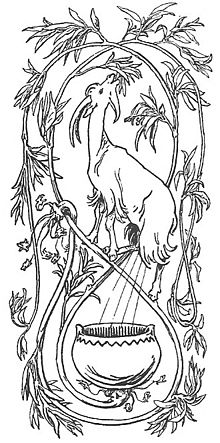Lärad
Lärad ( Old Norse Læraðr) is a tree in Norse mythology near Valhalla . The deer Eikthyrnir and the mead-donating goat Heidrun stand on the roof of Walhall and gnaw from the branches of the tree. Below Lärad is the Hvergelmir spring , because drops fall from the deer's antlers into the spring, from which all rivers in the world arise.
swell
“Heidrun is the name of the goat that
stands in the Heervaters hall
and eats from Lärad's branches;
she should fill the ladles with pure mead,
this drink cannot dry up.
Eikthrynir is the name of the deer that
stands in Heervater's hall
and eats from Lärad's branches;
and from his horn it
drips to Hwergelmir,
from there all rivers take their way. "
"Translation by Arnulf Krause"
“The goat named Heidrun stands on top of Valhalla and eats leaves from the branches of the tree that is very famous and is called Lärad. But the mead flows out of her udder and fills it into a large vessel every day. That's so much that everyone in the community has enough to drink from it. [...] The deer Eikthyrnir, which also likes Valhalla and eats from the branches of the tree, has even more importance. So much drips from its antlers that it runs down to Hwergelmir. And there the rivers flow out, [the following is a list of 25 river names]. "
"Translation by Arnulf Krause"
reception
The name Lärad perhaps means 'damage-rider' (Old Norse læ 'damage' and * raðr from Indo-European * redh- 'prepare') and possibly refers to the god father Odin , compare the meaning of Yggdrasil 'steed of the terrible' = Odin's horse. The Walhall location also speaks for the proximity to Odin. Other interpretations, which are linguistically more distant, are 'protective donors' or 'moisturizers'
The tree is equated with the world tree Yggdrasil , since Yggdrasil like Valhalla belongs to the center of the world and Hvergelmir is also located under the world tree.
Lärad could in particular be a variant of the world tree as a protective tree. In Sweden, a protective tree, the so-called Vårträd, often grew next to the house and was connected to the house. If the protective tree died, it was assumed that the further development of the house would also end. In addition, Lärad grows next to Odin's hall and that drops of the deer's antlers fall in Hvergelmir.
Since Lärad is only mentioned in Norse mythology in the Grimnir song, the tree is believed to be a mythological diagram of the pagan late period.
literature
- Rudolf Simek : Lexicon of Germanic Mythology (= Kröner's pocket edition . Volume 368). 3rd, completely revised edition. Kröner, Stuttgart 2006, ISBN 3-520-36803-X .
Individual evidence
- ↑ Grimnismál 25 f .; Gylfaginning 39
- ^ Gerhard Köbler: Old Norse Dictionary. 2nd edition, 2003. Online ( Memento of the original from April 12, 2009 in the Internet Archive ) Info: The archive link was inserted automatically and has not yet been checked. Please check the original and archive link according to the instructions and then remove this notice. . Old Norse læ 'pity, damage, loss, cunning, fraud', Old Norse * raðr 'advising' ?, from Germanic * redaz , from Indo-European * redh- 'prepare, make up, advise , consider'
- ↑ Old Norse * hléráðr . Compare Gerhard Köbler: Old Norse Dictionary. 2nd edition, 2003. Online ( Memento of the original from April 12, 2009 in the Internet Archive ) Info: The archive link was inserted automatically and has not yet been checked. Please check the original and archive link according to the instructions and then remove this notice. . Old Norse hlé 'protection'
- ↑ Compare Gerhard Köbler: Old Norse Dictionary. 2nd edition, 2003. Online ( Memento of the original from April 12, 2009 in the Internet Archive ) Info: The archive link was inserted automatically and has not yet been checked. Please check the original and archive link according to the instructions and then remove this notice. . Old Norse là 'beach water, sea'
- ↑ On the overall etymology: see Simek (2006) p. 240.
- ↑ John Arnott MacCulloch: Eddic. In: Canon John Arnott MacCulloch (ed.). The Mythology Of All Races, 13 vols. New York 1964, vol. 2 p. 333
- ↑ The passage in Gylfaginning, which belongs to the Prose Edda , in which the tree is also mentioned, seems to draw directly from the Grimnir song.
- ↑ Simek (2006) p. 240
